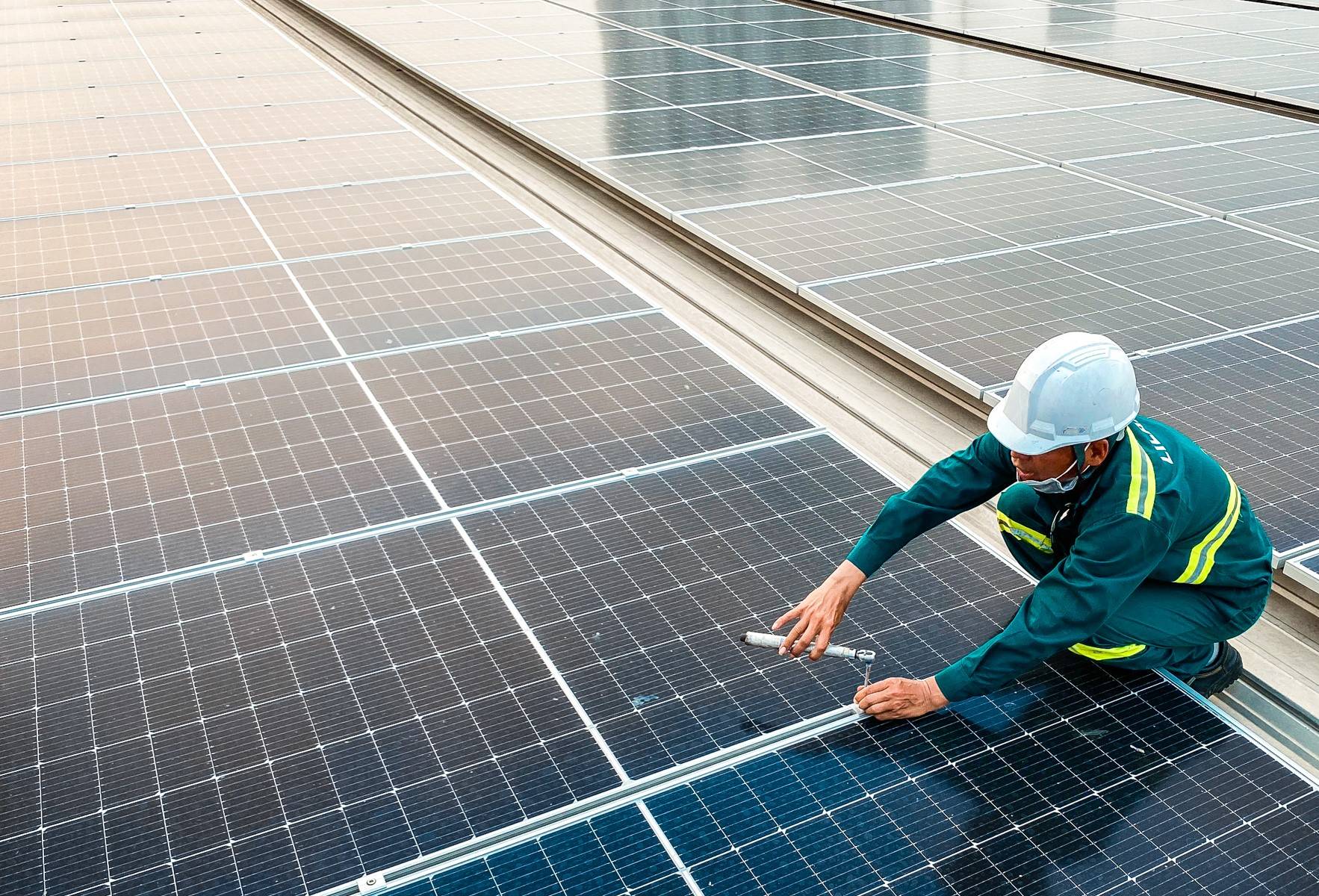Blog

Hướng đến mục tiêu phát triển bền vững và khẳng định cam kết trách nhiệm xã hội doanh nghiệp (CSR), GreenYellow Việt Nam đã tổ chức thành công hoạt động EcoDay 2025 với nhiều trải nghiệm ý nghĩa gắn liền với thiên nhiên và môi trường.
Vào ngày 19 tháng 6 năm 2025, tập thể GreenYellow Việt Nam cùng đồng hành với các chi nhánh GreenYellow trên toàn thế giới tham gia chương trình EcoDay 2025 – ngày hội hành động xanh toàn cầu của Tập đoàn. Đây là hoạt động thường niên nhằm nâng cao nhận thức môi trường trong nội bộ doanh nghiệp, đồng thời khuyến khích mỗi cá nhân thực hiện hành động thiết thực vì hành tinh.

Với thông điệp xuyên suốt “Một hành tinh – Một hành động – Một GreenYellow”, EcoDay là minh chứng rõ ràng cho tinh thần thống nhất và trách nhiệm toàn cầu trong việc bảo vệ môi trường sống. Dù ở bất kỳ vị trí nào hay quốc gia nào, tất cả thành viên GreenYellow đều hướng đến mục tiêu chung: kiến tạo tương lai xanh thông qua những hành động cụ thể.

Trải nghiệm thực tế gắn liền với thiên nhiên
Tại Việt Nam, đội ngũ GreenYellow đã chọn trekking và trồng cây xanh tại hai khu vực rừng đặc dụng tiêu biểu:
-
Khu bảo tồn thiên nhiên Bình Châu – Phước Bửu (Bà Rịa – Vũng Tàu): Nơi đây được xem là một trong những rừng nguyên sinh ven biển quý giá còn sót lại ở miền Nam Việt Nam. Hoạt động trekking giúp các thành viên hòa mình vào thiên nhiên, đồng thời trồng cây góp phần phục hồi hệ sinh thái địa phương.

-
Vườn quốc gia Cúc Phương (Ninh Bình): Là khu bảo tồn thiên nhiên lâu đời nhất Việt Nam, Cúc Phương mang giá trị lớn về đa dạng sinh học. Tại đây, GreenYellow đóng góp một phần vào việc trồng cây bản địa và lan tỏa nhận thức về bảo tồn rừng.

Không chỉ là một ngày làm việc tập thể ngoài trời, EcoDay còn là dịp để mỗi nhân viên nhìn lại vai trò cá nhân trong mục tiêu chung: giảm phát thải, bảo tồn đa dạng sinh học và hướng đến sử dụng năng lượng xanh một cách hiệu quả.
Trách nhiệm xã hội bắt đầu từ hành động nhỏ
Tại GreenYellow, các hoạt động vì môi trường không chỉ gói gọn trong các dự án năng lượng tái tạo mà còn được thể hiện qua những chương trình như EcoDay. Việc trekking, trồng cây và chia sẻ trải nghiệm với đồng nghiệp chính là cách mà tập thể GreenYellow Việt Nam xây dựng văn hóa doanh nghiệp xanh, nhân văn và gắn kết.

Thông qua EcoDay 2025, GreenYellow khẳng định định hướng lâu dài trong chiến lược phát triển bền vững, nơi mỗi cá nhân đều là một “tác nhân xanh” đóng góp vào quá trình chuyển đổi năng lượng và bảo vệ hành tinh chung.

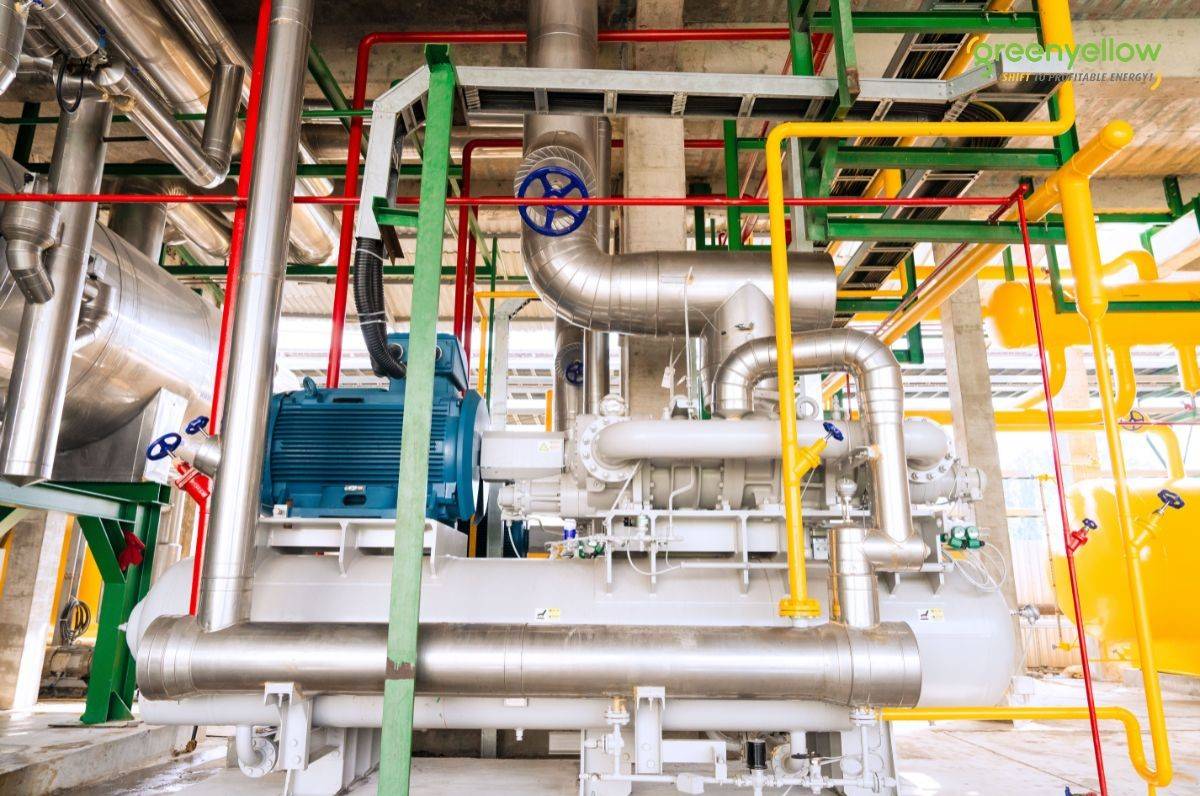
We encounter residential cooling systems daily, such as home air conditioners, and commercial refrigeration systems in supermarkets and shopping malls. But what about industrial refrigeration systems? Let’s explore their components and applications in commercial and industrial sectors with GreenYellow!
What is an industrial refrigeration system?
An industrial refrigeration system is a set of equipment designed to cool or maintain stable temperatures in industrial processes, including production, storage, and transportation of goods. The key difference between industrial refrigeration systems and residential cooling systems lies in their size, capacity, and operational requirements.
With increasingly advanced technology, industrial refrigeration systems not only help preserve product quality but also play a crucial role in energy savings and enhancing production efficiency.
Components of an industrial refrigeration system
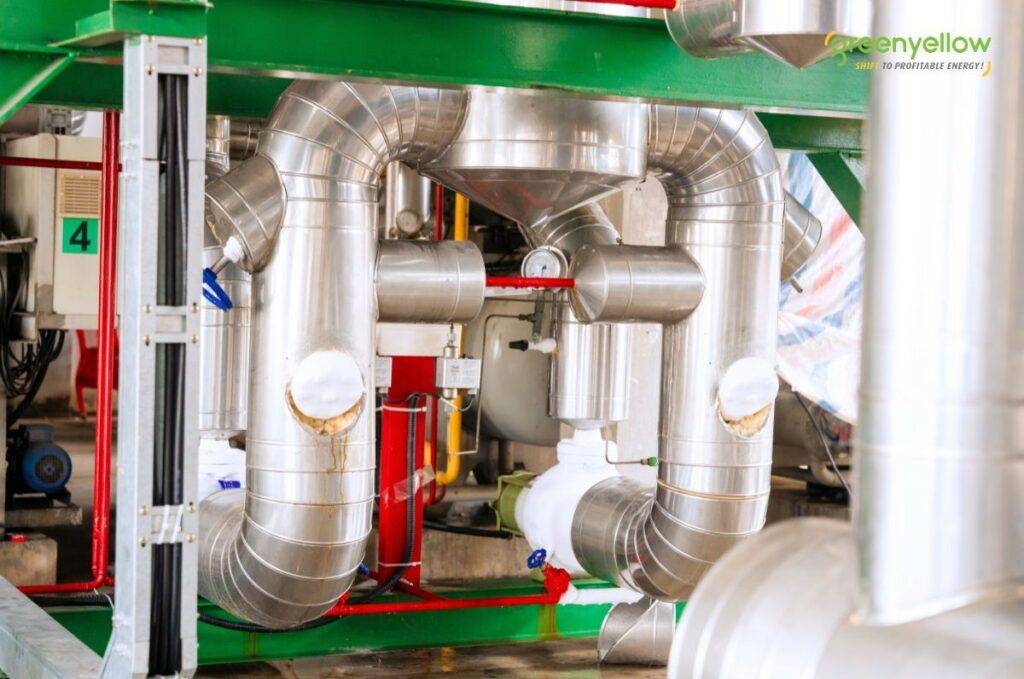
Components of an industrial refrigeration system:
- Industrial Air Compressor: This component is responsible for compressing refrigerant gas, increasing its pressure to facilitate cooling. See more types of refrigeration compressors here.
- Condenser: The refrigerant gas is cooled and condensed into liquid form in this unit.
- Evaporator: Absorbs heat from the surrounding air, lowering the temperature of the designated cooling space.
- Piping System: Transfers the refrigerant liquid between the condenser and evaporator.
- Temperature Control & Sensors: Ensure stable temperature regulation throughout the operation.
- Fan: Circulates air within the system.
Applications of Industrial Refrigeration Systems
Industrial refrigeration systems play a crucial role in various industries, ensuring product quality and maintaining stable production processes. Below are some key applications across different sectors.
Healthcare & Pharmaceuticals
In the medical field, industrial refrigeration systems are essential for preserving medicines, vaccines, and other temperature-sensitive medical products. Cold storage facilities and industrial refrigeration systems help maintain ideal conditions, ensuring product effectiveness and safety.
Frozen Food Processing
Industrial cooling systems is indispensable in the food industry, especially in freezing fruits and seafood. According to the Ho Chi Minh City Energy Conservation Center (ECC HCMC), energy costs rank third in the seafood value chain, with refrigeration accounting for up to 70% of total electricity consumption.
To improve efficiency, companies like Bạc Liêu Seafood JSC have invested in upgrading their industrial refrigeration system , while Relifoods has adopted energy-saving solutions to enhance their IQF, frozen food production.
Retail Chains
Refrigeration systems in retail and shopping centers serve multiple purposes - creating a comfortable environment for customers and preserving perishable goods to ensure freshness and quality.
For example, Mega Market partnered with GreenYellow to optimize energy usage, saving 17,153 billion VND in electricity costs over ten years and reducing energy consumption by 13.59%, improving overall supermarket efficiency.
Other
Beyond food and retail, industrial refrigeration systems are critical in various fields: Data centers require cooling solutions to maintain optimal conditions for servers and IT infrastructure. Chemical manufacturing relies on cooling systems to regulate temperatures in production processes, preventing uncontrolled chemical reactions due to excessive heat.
Now you have a better grasp of industrial refrigeration systems - their key components and real-world applications. Understanding their role helps businesses make smarter choices, cutting down on operational and production costs.
With 17 years of global experience, GreenYellow has been the trusted partner for industrial refrigeration upgrades and enhancements in Vietnam. Our tailored financial & technical solutions let you focus on growing your business while we handle your energy needs.
Get in touch with GreenYellow Vietnam for a free consultation today!
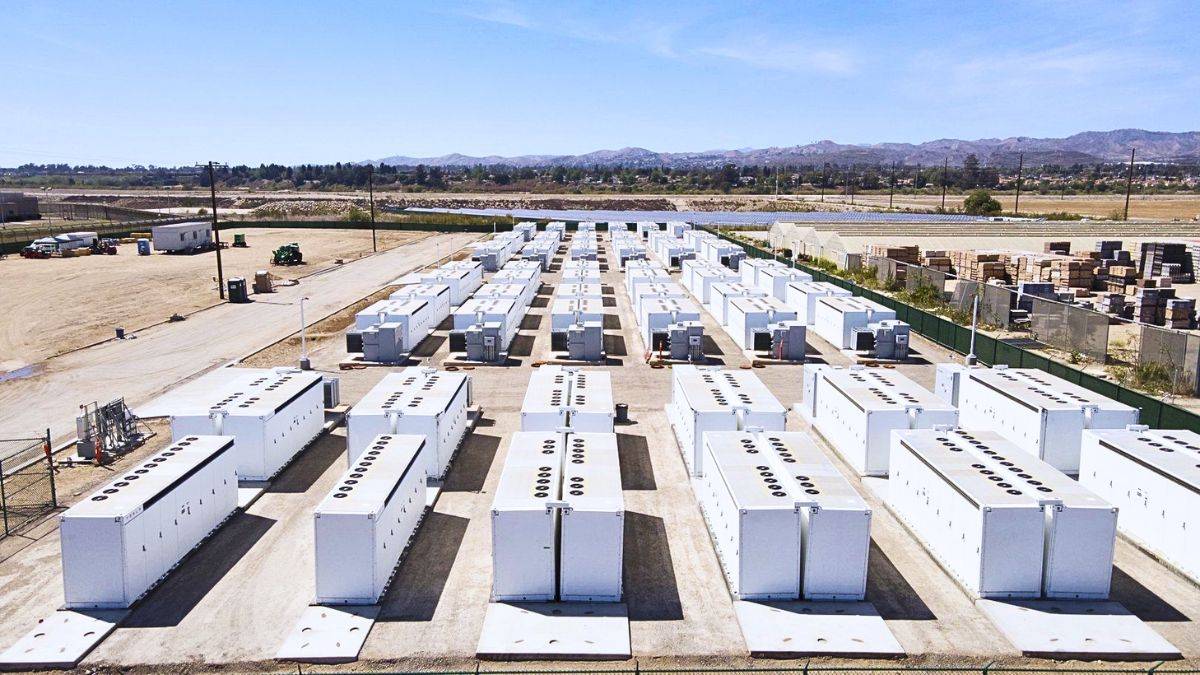
The rapid growth of Battery Energy Storage Systems (BESS) and fluctuating electricity prices are driving businesses to adopt smarter energy strategies. Since early 2023, Vietnam Electricity (EVN) has increased electricity prices by 12.5% within just 18 months - making cost-effective energy management more critical than ever. So, how can businesses invest in battery energy storage systems for maximum efficiency?
3 Benefits of investing in Battery Energy Storage Systems
As challenges in maintaining grid stability continue to rise, the demand for energy storage systems to minimize costs and enhance energy efficiency becomes increasingly urgent. Investing in an energy storage system is a strategic move that allows businesses to maximize profits in an ever-changing energy market.
Battery Energy Storage Systems enables the storage of electricity when prices are low and its use during peak hours when prices soar. This not only significantly reduces operating costs but also optimizes energy usage, improving long-term economic efficiency.

How to Invest in Battery Energy Storage Systems for maximum efficiency
There are 2 common investment approaches for deploying a BESS system: the first is to carry it out yourself through installation contractors, and the second is to partner with a comprehensive energy investment provider such as GreenYellow.
1. Self-investment
With the self-investment approach, you have full control over the project—from equipment selection, design, and construction to operation and maintenance. However, the investment cost for an energy storage system is high, and the installation process requires contractors with technical expertise and in-depth understanding of the system. Therefore, finding reputable and suitable partners can be time-consuming and costly.
2. Partnering with a comprehensive energy solutions provider
An alternative approach is to collaborate with an energy solutions provider offering 0-CAPEX upfront investment. In this model, all equipment, design, installation, operation, and maintenance are handled by a third party under contractual agreements, ensuring alignment with business needs. This model is similar to solar power installation through investment partners.
Investing through a comprehensive energy solution provider eliminates the pressures of cost, technical complexities, and operational concerns, while ensuring system performance and maintenance. This is considered a financially flexible solution for your business, allowing you to allocate capital and resources to core business activities instead of making large investments to develop a BESS system on your own.
Read more: Ways to jump-start the energy transition in Vietnam
Integrating Battery Energy Storage Systems with solar power systems
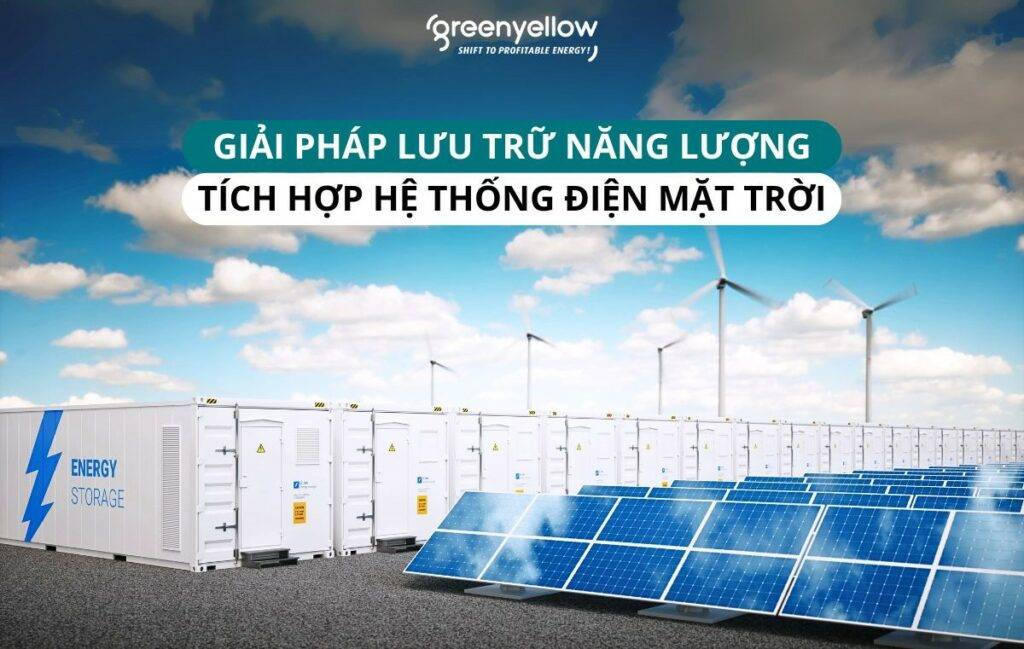
GreenYellow has developed energy storage solutions and is currently piloting its first projects in Vietnam. As your trusted energy partner, we offer cutting-edge Battery Energy Storage Systems solutions tailored to your business needs.
With models like Battery as a Service (BaaS) and Power Purchase Agreements (DPPA or Solar PPA) that provide 100% capital funding, you can store excess solar power (or other energy sources) and optimize your energy strategy. By working with us, you can achieve significant energy cost savings while focusing on their core operations. Our team ensures a seamless experience, from design and installation to operation and maintenance, executed with professionalism and efficiency.
Don’t let rising electricity costs impact your bottom line. Contact us today to explore how our energy storage solutions can help your business save more and grow smarter.
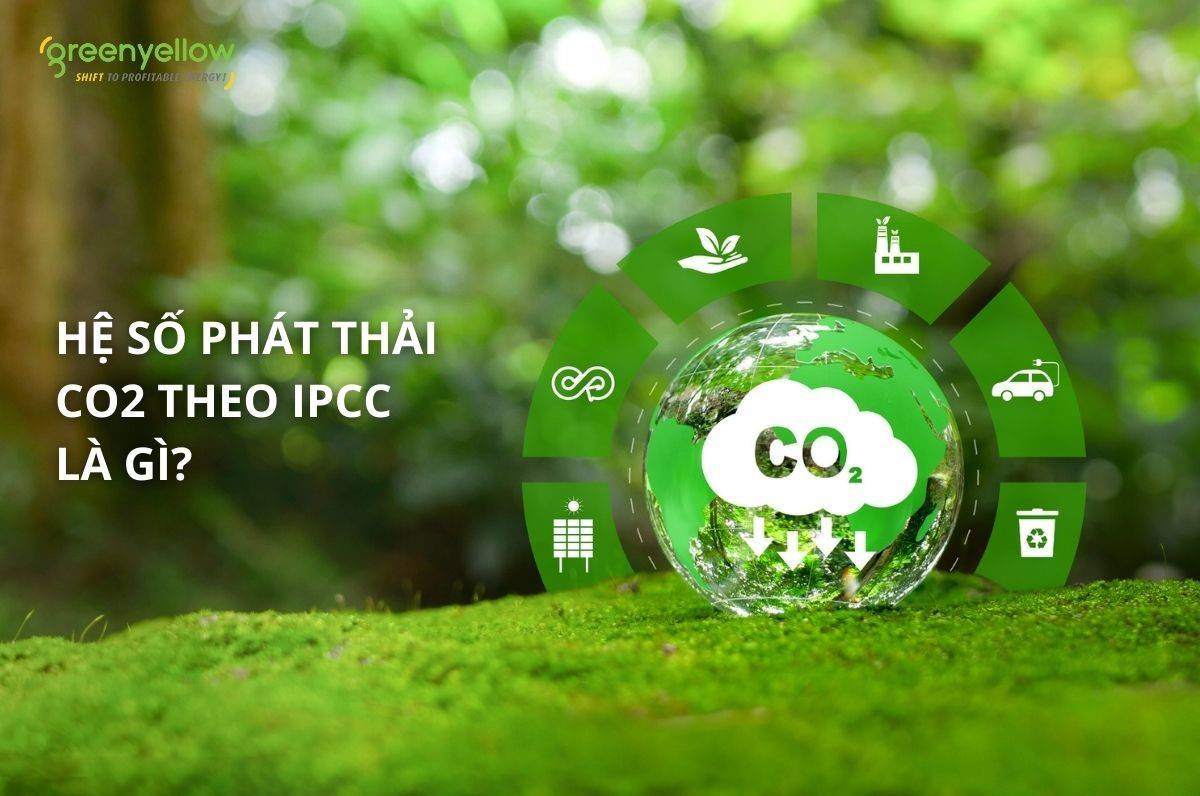
To reduce emissions and achieve environmental goals, the first step is to measure the carbon footprint of both you and your business. Calculating CO2 emissions is the initial step in assessing energy consumption and its environmental impact. So, what is the CO2 emission factor, and how is it calculated?
What is IPCC CO2 Emission?
The CO2 emission factor according to the IPCC is an index used to measure the amount of greenhouse gas emissions, primarily carbon dioxide (CO2), released when generating a specific amount of electricity. A common unit for expressing the emission factor is tons of CO2 per megawatt-hour (tCO2/MWh) or tons of CO2 equivalent per megawatt-hour (tCO2e/MWh).
The CO2 emission factor reflects the level of CO2 emitted into the environment per unit of energy produced or consumed. A lower or decreasing CO2 emission factor over time indicates that the electricity grid is relying more on clean energy sources such as solar and wind power, rather than fossil fuels like coal or natural gas, which have higher emission factors.
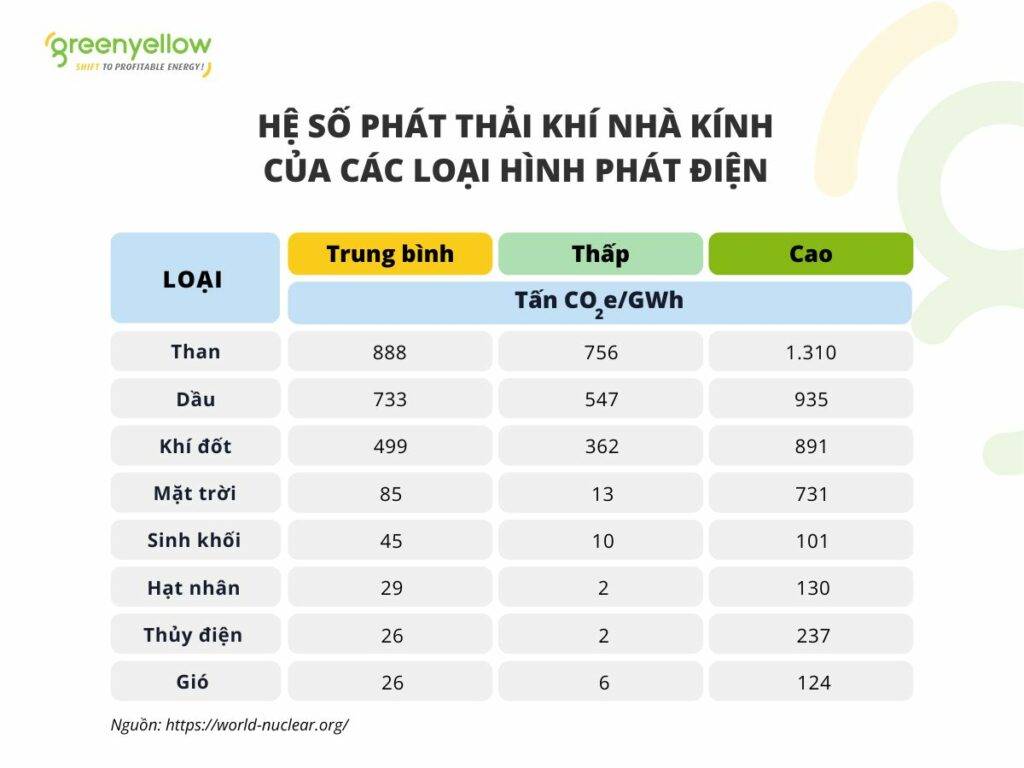
What is the emission factor of Vietnam's national power grid?
We know what the CO2 emission factor according to the IPCC is, but what is the emission factor of Vietnam's national power grid? In Vietnam, the emission factor of the national power grid is announced annually by the Department of Climate Change under the Ministry of Natural Resources and Environment. Below is a table summarizing the greenhouse gas emission factors of Vietnam's power grid from 2014 to 2022.
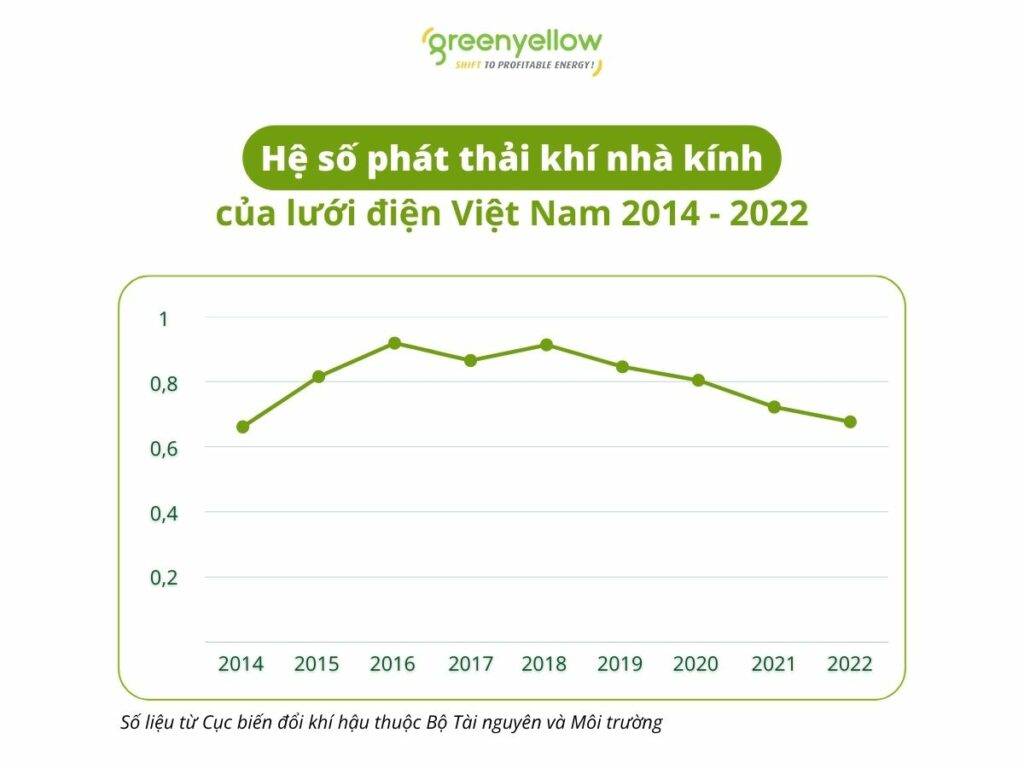
Currently, there is no official data available for the latest figures. However, you can refer to an article by Dr. Lê Hải Hưng from Hanoi University of Science and Technology, which estimates that the greenhouse gas emission factor of Vietnam’s power grid in 2023 will be 0.6559 tCO₂/MWh.
From 2015 to 2020, the construction of coal and gas-fired power plants led to an increase in the emission factor. However, since 2021, as solar and wind energy began to take up a larger share of the energy mix, this factor has decreased.
According to the VIII Power Development Plan, with the goal of gradually reducing the use of fossil fuel-based power sources and moving towards full reliance on renewable energy to achieve the Net-Zero target by 2050, we can expect that the greenhouse gas emission factor of Vietnam’s power grid will continue to decrease. This means that our electricity will become cleaner, contributing to environmental protection and mitigating the impacts of climate change.
Renewable Energy: The Key to Reducing CO2 Emission Factors
Based on the CO2 emission factor data from the IPCC, renewable energy sources such as solar and wind power are clearly playing a critical role in reducing greenhouse gas emissions. A life cycle assessment (LCA) study from the U.S. National Renewable Energy Laboratory (NREL) shows that transitioning from coal to renewable energy can reduce CO2 emissions by hundreds of millions of tons each year, significantly contributing to slowing climate change.
This result confirms that solar energy is one of the cleanest energy sources when considering its entire life cycle. To mitigate the impacts of climate change, transitioning from coal to renewable energy sources, especially solar power, is an essential step toward a more sustainable future.
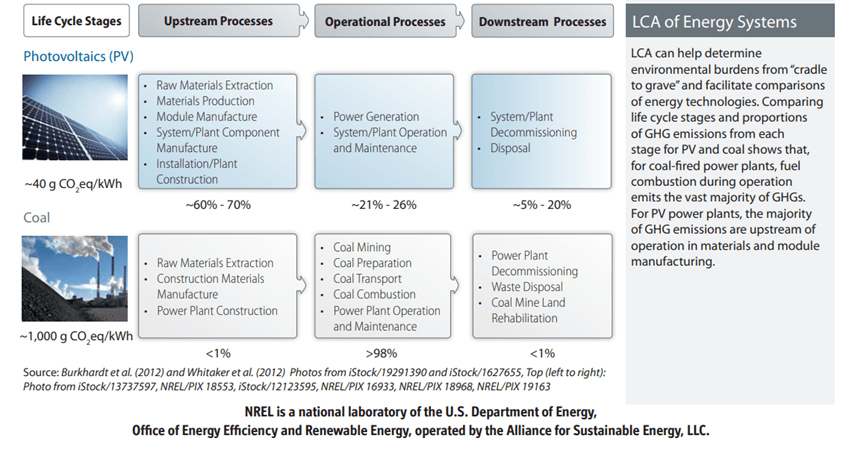
Unleashing Green Potential with Comprehensive Energy Solutions
After reading this article, we now understand what the CO2 emission factor according to the IPCC is. On the journey to a sustainable future, GreenYellow is proud to offer comprehensive solutions that support efficient green transitions and minimize greenhouse gas emissions. With our all-inclusive solar energy solution, available with 0 CAPEX, you will save significantly on electricity costs starting from the first month, while also receiving the international I-REC certification, which affirms your company's commitment to using renewable energy.
GreenYellow is committed to supporting businesses throughout the project lifecycle—from developing a comprehensive emission reduction roadmap, implementation, and permitting, to system operation and maintenance. Contact us now for quick assistance with the optimal energy solution for your business!
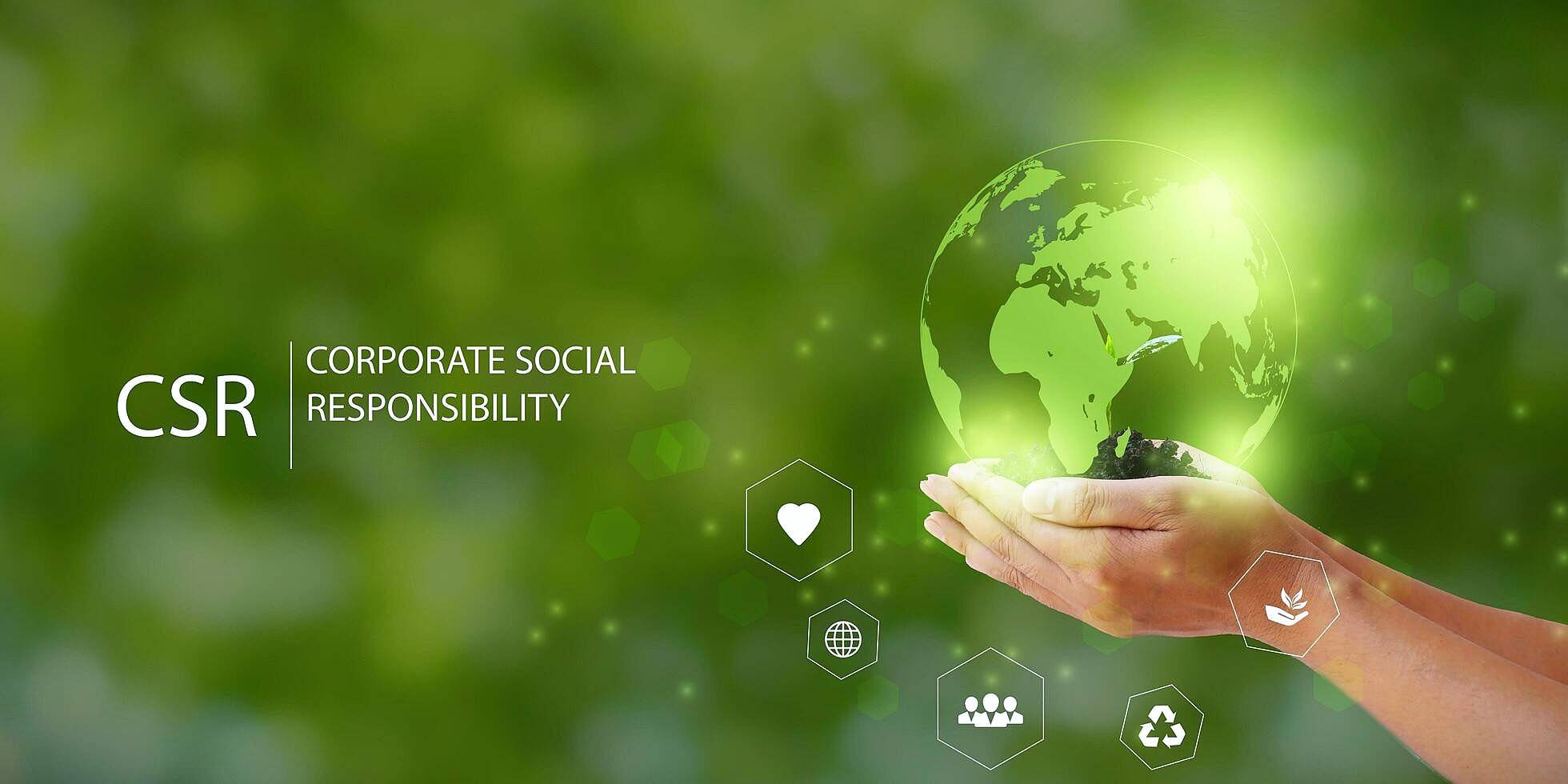
In today’s fast-paced world, consumers, partners, and employees are no longer just looking at the price tag – they’re also evaluating companies based on their commitment to making a positive impact on the world. Corporate Social Responsibility (CSR) is not just a buzzword, it’s a powerful tool that can set your business apart. In our previous article, we explored the role of CSR in businesses, but today, let’s dive into the real benefits that CSR can bring to the table.
What are the types of Corporate Social Responsibility?
Corporate Social Responsibility (CSR) involves activities aimed at making a positive contribution to the community, protecting the environment, and ensuring social welfare. In the community aspect, these activities include supporting charitable projects, education, healthcare, improving the lives of vulnerable groups, and building infrastructure such as schools and hospitals.
On the social front, businesses ensure the rights of workers by providing a safe and fair working environment while offering career development opportunities through training programs. Companies also focus on initiatives that support vulnerable groups in society.
Regarding the environment, businesses commit to reducing emissions, using renewable energy, and recycling to protect ecosystems. They also implement energy-saving measures to contribute to sustainable development.
Benefits of Corporate Social Responsibility
Benefits of Corporate Social Responsibility include
-
Boost your brand image and reputation
When your company commits to CSR, it sends a strong message to customers and partners that you care about more than just profit. By investing in environmental sustainability and community initiatives, you not only help make the world a better place but also position your brand as trustworthy and responsible.
Read more: GreenYellow Vietnam CSR Commitments
-
Attract and retain top talent
Today’s workforce isn’t just looking for a paycheck - they want to work for a company that aligns with their values. Adopting CSR initiatives, your business becomes a magnet for top talent who share your vision.
-
Strengthen community and government relationships
One of the most rewarding benefits of CSR is the positive impact it has on your relationship with local governments and communities. When companies like yours implement effective CSR strategies, it fosters trust, improves cooperation, and helps create a better business environment.
-
Unlock new business opportunities and markets
CSR opens doors. By engaging in socially responsible initiatives, your business can expand into new markets, attract like-minded partners, and collaborate with other brands that value sustainability. Plus, your commitment to green practices will make your products more attractive to eco-conscious consumers.
-
Secure financial support and investor trust
Investors are increasingly looking for companies that demonstrate a commitment to sustainable and socially responsible practices. When your company integrates CSR into its core strategy, you enhance your credibility, build trust with investors, and position yourself as a secure, long-term investment.
Building a sustainable future with CSR
The benefits of corporate social responsibility aren’t just about financial gains – they’re about creating a meaningful legacy. With GreenYellow’s expertise, you can ensure that your business not only thrives economically but also contributes to a better, greener world.
Our energy solutions, with zero upfront invesment, will help you reduce operational expenses while earning internationally recognized certifications like I-REC. Let us help you build your green business reputation and secure a sustainable future.


